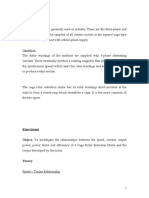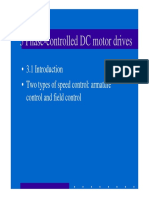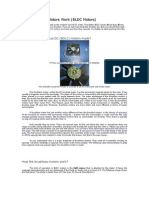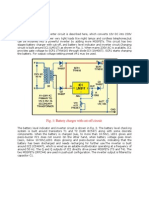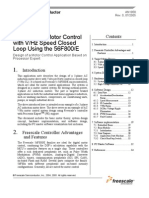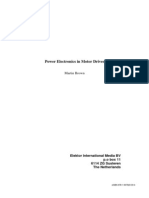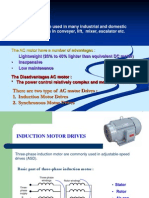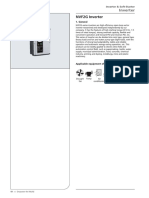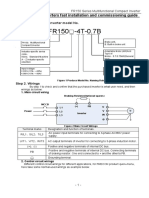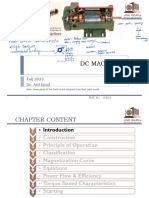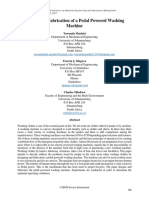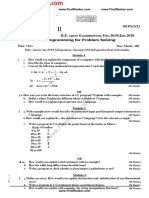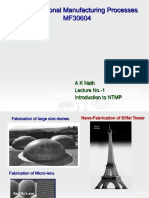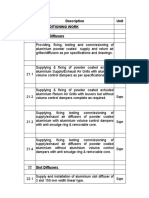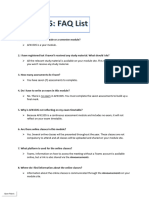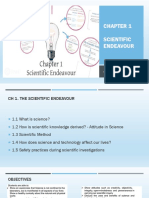Automatic Washingmachine
Uploaded by
DeepanshuAutomatic Washingmachine
Uploaded by
DeepanshuSee discussions, stats, and author profiles for this publication at: https://www.researchgate.
net/publication/344227457
Automatic Washing Machine with Direct Current Power Backup
Article · September 2020
DOI: 10.47545/etrj.2019.4.2.051
CITATIONS READS
0 2,285
6 authors, including:
Abayomi Isiaka Yussuff
Lagos State University
33 PUBLICATIONS 107 CITATIONS
SEE PROFILE
Some of the authors of this publication are also working on these related projects:
Rain attenuation studies View project
Crosstalk noise reduction using synthesized digital logic circuit View project
All content following this page was uploaded by Adetokunbo Adenowo on 13 September 2020.
The user has requested enhancement of the downloaded file.
Engineering & Technology Research Journal ISSN 0794-2834
Volume 4(2) pp. 7 - 16 (July - September 2019)
Automatic Washing Machine with Direct Current Power Backup
Adenowo A. A.1, Yussuff A.I.1, Adetona S.O.2, Ogunleye O.M.1,
Abioye O. K.1, Ahubelem C.G.1
1
Electronics and Computer Engineering Department, Lagos State University, Nigeria
2
Electrical and Electronics Engineering Department, University of Lagos, Lagos, Nigeria
*e-mail: abayomi.yussuff@lasu.edu.ng
Received: 16th April, 2019
Accepted: 22nd August, 2019
Published 17th September, 2019
https://doi.org/10.47545/etrj.2019.4.2.051
ABSTRACT
The design and construction of a simple but efficient automatic washing machine with direct current power backup
is presented in this paper. The machine is capable of washing, rinsing and dry-spinning clothes. The intelligence
of the machine was based on PIC16f628 microcontroller. This provides the sequence of instructions that controls
the machine from start to finish according to the washing mode selected. The machine is robust in design; with
local utilization of materials. 3 kg load of clothes at an average power consumption of 1.91 watt per minute
washing cycle was achieved. Furthermore, at power failure, the battery backup was automatically initiated to
complete the washing operation.
Keywords: Automatic washing machine, Power backup, Local materials, Microcontroller
1. INTRODUCTION
A washing machine is a mechanism designed to wash laundry, such as clothing, towels, and sheets. The term is
mostly applied only to machines that utilize water as the primary cleaning solution, in contrast to dry cleaning
(which uses alternative cleaning fluids, and is performed by specialist businesses) or ultrasonic cleaners [1].
Laundry washing involves immersing, dipping, rubbing, or scrubbing in water, usually accompanied by soap,
detergent, or bleach. Cloth washing is an essential part of human life. However, it involves considerable time,
effort, and energy, which may be sometimes considered undesirable. Prior to the use of washing machines to wash
cloths, clothes are washed by laboriously scrubbing each section of cloth over a cement washboard or flat stone
with hands immersed in detergents or soda soap that are harmful to the skin. Women are often left to take up this
responsibility. The quest for easier way of doing this household chore culminated in the design of hand operated
washing machine. This graduated to the invention of electric-powered washing machine. The development trend
continued to the design of mechanically timed switch controlled machine which eventually led to the modern day
electronic and micro-processor controlled automatic washing machine [2]. It was reported by [1] that Hamilton
Smith patented the rotary washing machine in 1858, while [2] and [3] reported that Alva J. Fisher invented the
first ever electric-powered washing machine in 1908.
Various design specifications have been adopted in the design of washing machine. A version of pedal powered
washing machine was earlier designed [1]. The main structure was built out of modified bicycle frame. The inner
drum was mounted on one side of a pedal shaft. The rotational force due to pedalling turns the drum via a drive
gear attached to the pedal shaft. A version of pedal powered washing machine similar to the one reported in [1]
was designed by [4]. Again, pedal-powered washing machines were also reported in [5-8]. They were all based
on simplicity of design and human power as shown in Figure 1.
Various researchers have come up with a variety of automatic washing machines that are based on different control
mechanisms. The automatic control of washing machine proposed in [9] used Application Specific Integrated
Circuit (ASIC), using a programmed Hardware Description Language (VHDL). However, the control unit of the
machine that was proposed in [10] was based on Programmable Logic Controller (PLC); while the intelligent
control unit of the one proposed in [11] utilized PIC18F452 microcontroller. The automatic washing machines
proposed in [9-11] employed complex approaches in solving what can easily be achieved with a simple technique.
Aside identified gap, all the machines lack power backups.
Adenowo et al, 2019 7 www.etrj.com.ng
© 2019 Faculty of Engineering, Lagos State University, Ojo. Nigeria. All rights reserved.
Engineering & Technology Research Journal ISSN 0794-2834
Volume 4(2) pp. 7 - 16 (July - September 2019)
Figure 1. Pedal-powered washing machine [4]
The design and construction of automatic washing machine with battery backed up system is presented. It employs
a simple but efficient control mechanism based on PIC16F628 microcontroller with a dc power backup. The
battery backup initiates automatically when utility main supply is no longer available.
2. METHODOLOGY
Structurally, automatic or semi-automatic washing machines are classified into either top and front loading
systems. In top loading washing machines, the lid is located at the top and laundry is loaded from there. It has its
washing basket placed vertically. At the centre of it is the agitator which rotates on the vertical axis, turning the
clothes. In front loading, the lid is in the front and the laundry is placed in there. There are paddles on the side of
the basket which helps move the clothes and stir water while the basket rotates. The paddles help remove dirt from
the clothes by creating friction. The basket is placed in the horizontal direction with no use of agitator [12], [13].
The design utilised here combines the technology of top loader and front loader together in a simplified, efficient
and affordable manner. The advantages of both technologies are utilized in this design. The salient advantages of
this hybrid design include:
a) It is top loader, hence no need of bending down to load in clothes.
b) The washing basket is pivoted horizontally inside a larger tub, hence it uses less water and soap/detergent
to wash clothes.
c) Since it is top loader, there is no issue of water leakage through the door or mould built up causing odour
as it is found in commercial front loaders.
d) It can be opened in mid cycle to add water or soap if need arises without water spillage through the door
opening.
e) It is gentle on clothes as it uses gravity to tumble clothes.
f) The mechanism and control system is not complicated which makes it affordable and serviceable.
g) In case of power failure, there is battery backup power to complete the washing operation. Washing can
even be initiated in the absence of mains power supply
2.1 Design Analysis and Considerations
The model adopted in this approach involves a combination of perforated inner cylindrical drum, pivoted
horizontally, and rotating inside a stationary outer tub that is filled with water at the top to a limited level from
bottom. The machine uses electrical power to operate and is fully controlled automatically. Figure 2 shows the
block diagram of the proposed machine.
Adenowo et al, 2019 8 www.etrj.com.ng
© 2019 Faculty of Engineering, Lagos State University, Ojo. Nigeria. All rights reserved.
Engineering & Technology Research Journal ISSN 0794-2834
Volume 4(2) pp. 7 - 16 (July - September 2019)
Figure 2. Block diagram of the automatic washing machine
2.2 Design of Outer Washing Tub (OWT)
The overall dimension is about 1 m3. It can be operated while standing without bending. To achieve this desired
size, the volume of the OWT, 𝑉𝑂𝑊𝑇′ is taken as 0.075 𝑚3 ; therefore
𝑉𝑂𝑊𝑇 = 𝑙𝑒𝑛𝑔ℎ𝑡𝑂𝑊𝑇 × 𝑊𝑖𝑑𝑡ℎ𝑂𝑊𝑇 × 𝐻𝑒𝑖𝑔ℎ𝑡𝑂𝑊𝑇 = 0.075 𝑚3 (1)
It is assumed that the 𝑙𝑒𝑛𝑔ℎ𝑡𝑂𝑊𝑇 = 𝑊𝑖𝑑𝑡ℎ𝑂𝑊𝑇 = 0.40 𝑚; hence the height of the OWT is obtained as
𝑉𝑂𝑊𝑇 0.075
𝐻𝑒𝑖𝑔ℎ𝑡𝑂𝑊𝑇 = = = 0.47 𝑚
𝑙𝑒𝑛𝑔ℎ𝑡𝑂𝑊𝑇 × 𝑊𝑖𝑑𝑡ℎ𝑂𝑊𝑇 0.40 × 0.40
2.3 Design of Inner Washing Tub (IWT)
The Inner Washing Drum (IWD) is a cylinder as depicted in Figure 2; hence its volume 𝑉𝐼𝑊𝐷′ is therefore
𝑉𝐼𝑊𝐷 = 𝜋 (𝑅𝑎𝑑𝑖𝑢𝑠𝐼𝑊𝐷 )2 × 𝐻𝑒𝑖𝑔ℎ𝑡𝐼𝑊𝐷 (2)
For a specified an average width of 0.05 𝑚, which is maintained round the inner washing tub as it rotates inside
the 𝑂𝑊𝑇, height of the 𝐼𝑊𝐷 is therefore given as
𝐻𝑒𝑖𝑔ℎ𝑡𝐼𝑊𝐷 = 𝑊𝑖𝑑𝑡ℎ𝑂𝑊𝑇 − (0.05 + 0.05) = 0.40 − 0.10 = 0.30 𝑚;
Again, with a design specification of 𝑉𝐼𝑊𝐷 = 0.025 𝑚3 , the radius of IWD yields
1 1
𝑉𝐼𝑊𝐷 2 0.025 2
𝑅𝑎𝑑𝑖𝑢𝑠𝐼𝑊𝐷 =( ) = ( ) = 0.150 𝑚
𝜋 × 𝐻𝑒𝑖𝑔ℎ𝑡𝐼𝑊𝐷 𝜋 × 0.300
For a design specific water height of 0.13 𝑚 from the base of the 𝑂𝑊𝑇, the total volume of water 𝑉𝑇𝑜𝑡𝑎𝑙 is
𝑉𝑇𝑜𝑡𝑎𝑙 = 0.40 × 0.40 × 0.13 = 0.022 𝑚3
The weight of inner washing drum is 3.5 kg; hence a maximum of 3 kg of laundry can be loaded.
2.4 Selection of electric motor
Adenowo et al, 2019 9 www.etrj.com.ng
© 2019 Faculty of Engineering, Lagos State University, Ojo. Nigeria. All rights reserved.
Engineering & Technology Research Journal ISSN 0794-2834
Volume 4(2) pp. 7 - 16 (July - September 2019)
Information provided in [14] presents a good guide in the choice of the appropriate dc electric motors rating. The
experimental result thereof proved that the motor performed without hitches in all tests conducted for loads
between 2kg and 5kg. And since the design specification for this washing machine under consideration is for a
total load of 3kg, and from energy consumption pattern in Figure 3, a dc motor of 200W, 24V, no load current of
0.25A, maximum load current of 16A, and speed 2800 rpm was selected (for a dc power backup for one hour).
Figure 3. The plot of energy consumption (Wh) versus weight of dry clothes (Kg) [14]
In order to reduce the motor speed by a ratio of 5:1, a pulley of 30.5 cm diameter was fabricated and installed.
The motor speed could also be further varied by varying the applied voltage. Again, high speed spinning was
achieved by higher voltage, which is above the normal voltage applied during washing and rinsing.
2.5 Design of Washing Basket
The washing basket/drum was fabricated out of a flat stainless steel sheet of 96.5 cm by 30.5cm. Stainless steel
was chosen among possible alternatives because of the following advantages:
a) It is rust-free. It will be immersed in water always hence, the choice to prevent rust.
b) It is durable. It has a high tensile strength.
c) It can be bent without kinking.
It was perforated before folding to form a cylinder of height 30.5 cm and a circular face of 30.5 cm diameter. The
circular face was welded to the cylinder to form the washing drum. Three triangular fins (agitator jaws) were also
fabricated and fitted inside the drum. This agitates the clothes during wash cycle. The whole washing basket was
later banded with aluminium frame for rigid support on its axis of rotation. The inner washing basket design is
shown in Figures 4.
Figure 4. Inner Washing Basket
Adenowo et al, 2019 10 www.etrj.com.ng
© 2019 Faculty of Engineering, Lagos State University, Ojo. Nigeria. All rights reserved.
Engineering & Technology Research Journal ISSN 0794-2834
Volume 4(2) pp. 7 - 16 (July - September 2019)
2.6 Fabrication of the Outer Tub
The outer tub as shown in Figure 5 is made of acrylic material to ensure transparency as required for the machine
Other competing material is thick plastic. The acrylic material is 10 𝑚𝑚 thick by the sides that support the bearing
whereas, other sides are 5 𝑚𝑚 thick. This material was resized to form a box of dimensions 40 𝑐𝑚 × 40 𝑐𝑚 ×
47 𝑐𝑚 which give a volume of 75,000 𝑐𝑚3 . The outer tub is shown in Figure 5.
Figure 5. The Outer tub
2.7 Fabrication of Basic Components of the Washing Machine
The frame was made of wood, constructed in form of chair with back rest. This is sturdy enough to carry the
weight of the whole machine assembly. It provides stability, as well as electrical insulation. The outer metal sheet
covering was also screwed to it. Other components of the machine that worth mentioning includes: the bearing
support, the pulley, the clamp, the V-belt. The design views of the machine are shown in Figure 6; while finalized
view under testing is presented in Figure 7.
(a) Basic working components of the washing machine
Adenowo et al, 2019 11 www.etrj.com.ng
© 2019 Faculty of Engineering, Lagos State University, Ojo. Nigeria. All rights reserved.
Engineering & Technology Research Journal ISSN 0794-2834
Volume 4(2) pp. 7 - 16 (July - September 2019)
(b) Agitator motor and pulley relationship view
Figure 6. Design views of the machine
Figure 7. Finalized view of the machine under testing
2.8 Electrical Power and Control Circuit Design
The D.C power supply to motor and other units was primarily derived from the mains supply. A centre-tapped
220/24 Volts, 500 VA transformer was used as a step down transformer.
The output was rectified using a 20 A bridge rectifier. This was filtered by capacitors connected across the output
of the bridge rectifier in other to remove harmonics and ripples. Several adjustable voltage regulators, LM317
were then configured and trimmed to deliver appropriate voltages to various sections of the circuits. The circuit
diagram is shown in Figure 8.
Adenowo et al, 2019 12 www.etrj.com.ng
© 2019 Faculty of Engineering, Lagos State University, Ojo. Nigeria. All rights reserved.
Engineering & Technology Research Journal ISSN 0794-2834
Volume 4(2) pp. 7 - 16 (July - September 2019)
TIP147
Q2
U2 LM317S
R3 3 1
VI VO Vout 24v
22R
ADJ
C4
R4
2
470u
TR1
15v 220R
TIP147
BR1
Q1
U1 RV2
LM317S
R1 3 1
5K
VI VO Vout 12v
C1 22R
ADJ
BRIDGE 7900u
50v C3
TRAN-2P3S 15v
2
470u
R2
RV1 220R
C2
50v 5K
7900u
(A) POWER SUPPLY FOR MOTOR
U4 7805
Q3 12v input
1
VI VO
3
5v output
GND
TIP147 U3
LM317S
R5
2
TR2
3
VI VO
1
Vout 28v C6
22R 0.1u
ADJ
35v
BR2
2
220R
R6
BRIDGE
RV3 C5
35v
5K
TRAN-2P2S 0.1u
(C) POWER SUPPLY FOR MICRO-CONTROLLER
(B) CHARGER CIRCUIT FOR BACK UP BATTERY
Figure 8. Power Supply circuit to various sections
2.8.1 Filter Capacitor Selection
The power supply supplies 16 𝐴, 𝑎𝑡 24 𝑉 𝑎𝑡 50 𝐻𝑧 𝑓𝑟𝑒𝑞𝑢𝑒𝑛𝑐𝑦 at a power factor and ripple factor of 0.8 and
0.25 respectively. The required filter capacitor is
1
𝐶= (3)
(4√3𝑓⋋𝑅𝐿 )
𝑉𝐿𝑜𝑎𝑑 24
In equation (3), 𝑅𝐿 (Load resistance) is = 𝑜𝑟 1.5 Ω; therefore the required 𝐶 is 7,900 µ𝐹.
𝐼𝐿𝑜𝑎𝑑 16
2.8.2 Voltage Regulation Selection
The LM317, an adjustable voltage regulator was used in the design of the regulated output voltages to various
sections. The relationship between output voltage and the biasing resistors is
𝑅2
𝑉0 = 1.25 (1 + ) (4)
𝑅1
It has been specified in the data sheet that 𝑅1 should not be more than 1 kΩ; hence, 𝑅1 is assumed to be 220 Ω.
𝑅2 is therefore
𝑉0 −1.25 24−1.25
𝑅2 = 𝑅1 ( ) = 220 ( ) ≅ 4 𝑘Ω
1.25 1.25
In this contribution, a trim potentiometer of 5 kΩ was then used as 𝑅2 for the regulator circuit. With duplicates of
this circuit, any voltage can then be achieved below or a little above 24 V. The TIP147 serves as a high current
pass. It is rated 15A.
2.8.3 Intelligent Control Design
Adenowo et al, 2019 13 www.etrj.com.ng
© 2019 Faculty of Engineering, Lagos State University, Ojo. Nigeria. All rights reserved.
Engineering & Technology Research Journal ISSN 0794-2834
Volume 4(2) pp. 7 - 16 (July - September 2019)
All the control functionalities of the proposed machine were built around 16F628A microcontroller. The controller
was designed and programmed to control the supply of water in and out of the washing machine, the timings for
washing, rinsing and drying as well as status indication and alarm, all to be performed in sequence automatically.
Figure 9 shows the pin assignments of the microcontroller for signals and status indications. The sequence of
operations of the machine at different modes is shown with their respective time allocations in Table 1.
U1
16 17
RA7/OSC1/CLKIN RA0/AN0 To drier and fan relay driver
alarm 15 18
RA6/OSC2/CLKOUT RA1/AN1 start button
1
RA2/AN2/VREF To motor forward rotation relay driver
4 2
RA5/MCLR RA3/AN3/CMP1 mode switch
3
RA4/T0CKI/CMP2
6
RB0/INT stop button
7
RB1/RX/DT To motor reverse rotation relay driver
8
RB2/TX/CK mode 1 indicator
9
RB3/CCP1 mode 2 indicator
10
RB4 mode 3 indicator
11
RB5 To water inlet relay driver
12
RB6/T1OSO/T1CKI signal to switch motor to 24v
13
RB7/T1OSI To water outlet relay driver
PIC16F628A
Figure 9. Functions assigned to microcontroller Pins
3. RESULTS
The user is required to sort the clothes to be washed according to how dirty they are as well as according to colour.
The user loads clothes into the inner tub through the door on top and lock it. Put it in the detergent or liquid soap
as desired, and then select the appropriate washing mode out of the three pre-defined mode of washing. Once that
is done, the start button is then pressed. The controller will take over from there till finish.
The controller determines the required level of water that is allowed in, controls water exit as well as starting of
the motor for washing, rinsing and spinning. It has alarm that alerts the user of the end of the whole washing
process. The whole washing process takes about 41 to 56 minutes depending on the mode selected.
3.1 Backup Power
This consists of 24 V, 17 AH battery installed with charger to charge the battery. Since the motor is D.C operated,
this arrangement readily takes over the supply of power immediately mains supply fails.
Table 1 shows the sequence of timings of various stages of washing operations, depending on the washing mode
selected. Mode 1 is to be selected for soft and delicate cloths that require less time to wash. Mode 2 is selected
for moderately dirty cloth, while mode 3 is for jeans, towels and very dirty clothes that require much time to wash.
It will be observed that the water intake valve opens for 7/8 minutes. This is the time required for the water to
reach washing level in the outer washing tub. The flow rate of inlet water and the diameter of the valve accounted
for this. The machine performed quietly in all the modes while washing, but during dry-spinning operation, it
vibrates.
The testing carried out showed that the motor operates at an average speed of 60 revolutions per minute during
washing while the speed increases to 800 revolutions per minute during spinning. The average power consumption
was 86 watts when loaded with 3 kg of dry clothes. It takes an average time of 40 minutes to complete one cycle
of washing
Adenowo et al, 2019 14 www.etrj.com.ng
© 2019 Faculty of Engineering, Lagos State University, Ojo. Nigeria. All rights reserved.
Engineering & Technology Research Journal ISSN 0794-2834
Volume 4(2) pp. 7 - 16 (July - September 2019)
Table 1. Program sequence and timings
Water Washing Water Water Water Water Water Spinning Alarm
Mode Cloth Inlet Duration Outlet Inlet and Outlet in and Outlet Operation
type valve Valve rinse Valve rinse Valve
Opens Opens operation Opens Opens
(mins) (mins) (mins) (mins) (mins) (mins) (mins) (mins) (mins)
Soft 7 10 2 7 2 7 2 3 1
1 and
delicate
Modera 7 15 2 7 2 7 2 4 1
2 tely
Dirty
Clothes
Jeans, 8 20 2 8 2 8 2 5 1
3 Towels
and
very
dirty
clothes
4. CONCLUSION
Design and construction of an automatic washing machine based on D.C power supply and microcontroller
controlled is presented in this paper. The design marries the technology of top loader and front loader together in
a simplified, efficient and affordable manner. The advantages of both technologies are utilized in the design of
the hybrid washing machine such that it saves power, it saves water usage and detergent, it is convenient to operate,
it has low maintenance and is affordable. The machine has a D.C power backup to supply power during mains
supply failure.
It is recommended that the stability of the machine at high speed of spinning be looked into. This could be done
by incorporation of damper. Also, the use of permanent magnet motor can be explored in the design of a low cost,
low power automatic washing machine like this.
REFERENCES
[1] Jadoun R.S.; and Choudhary S.K. (2014). Design and Fabrication of manually driven pedal Powered
Washing Machine. Innovative Systems Design and Engineering, 5 (6) 56-68
[2] Akpobi J.A and Okonta J.A. (2007). Design and Construction of a Computer Controlled Clothes Washing
Machine. J. Appl. Sci. Environ. Manage. June, 2007, 11 (3) 249 – 251
[3] Mushiri T. and Mugova T.J. (2017). Design and Fabrication of a Pedal Powered Washing Machine,
Proceedings of the International Conference on Industrial Engineering and Operations Management
Bogota, Colombia, 355-366
[4] Hari Babu, A.V.; Subba R.; Naresh, P., M. V. and Sudhakar R. M. (2016). Performance of a Peddling
Washing Machine. International Journal of Current Research, 8 (9) 37865-37870 ·
[5] Naresh P.; Jaymin P.; Ashirin B.; and Nirav O. (2013). Peddling Washing Machine. Project Report,
Institute of Technology, India
[6] Laundering: A Pedal Powered Washing Machine. Available online at: www.igreenspot.com/laundering-
a-pedal-powered-washing-machine. Accessed in July, 2018.
[7] Olusegun A.S. (2011). Design and Fabrication of Pedal Powered Laundry Washing Machine. A Final
Year Project Report for the Award of B.Eng. in Mechanical Engineering, FUT, Minna, November 2011.
Adenowo et al, 2019 15 www.etrj.com.ng
© 2019 Faculty of Engineering, Lagos State University, Ojo. Nigeria. All rights reserved.
Engineering & Technology Research Journal ISSN 0794-2834
Volume 4(2) pp. 7 - 16 (July - September 2019)
[8] Ranjan A.; Sharan K.; and Mazumdar S. (2014). Pedal Powered Washing Machine (PPWM).
International Journal of Scientific & Technology Research, 3 (11) 97-103
[9] Gaur N.; and Bansod P.P. (2013). Front End Realization of Automatic Washing Machine. International
Journal of Computer Applications, 4th International IT Summit Confluence 2013 - The Next Generation
Information Technology Summit, 15-20
[10] Madhuri V. and Yerrathota N. (2016). Automatic Washing Machine Using PLC. International Journal of
Latest Trends in Engineering and Technology, 7 (2) 538-543
[11] Embedded System for Automatic Washing Machine Using Microchip PIC18F Series Microcontroller.
Available online at: http://asic-soc.blogspot.in/2007/12/embedded-system-for-automatic-washing.html
Retrieved July 2018.
[12] Ronca D. (2010). Top 5 benefits of Top-load washers. Available online at:
http://home.howstuffworks.com/top-5-benefits-of-top-load-washers.htm. Retrieved 23rd July, 2018.
[13] Clark D. (2014). 6 Major Differences between Front-Loading and Top-Loading Washing Machine.
Available online at: www.designlike.com/6-major-differences-between-front-loading-and-top-loading-
washing-machine Retrieved 23rd July 2018.
[14] Beemkumar. N. and Jason A. M. (2015). Energy and Water Consumption Analysis of Washing Process
in a Fully Automatic Washing Machine. International Journal of Applied Engineering Research, 10 (11)
10341-10344.
Adenowo et al, 2019 16 www.etrj.com.ng
© 2019 Faculty of Engineering, Lagos State University, Ojo. Nigeria. All rights reserved.
View publication stats
You might also like
- Exercise Session 4 and Lab 2: Washing Machine: The Programming Task0% (1)Exercise Session 4 and Lab 2: Washing Machine: The Programming Task4 pages
- Automatic Control of Hydraulic Machine Using PLCNo ratings yetAutomatic Control of Hydraulic Machine Using PLC5 pages
- 3 Phase Motor Programmable Controller Report 2No ratings yet3 Phase Motor Programmable Controller Report 23 pages
- Water Level Detector Using 8051 MicroconNo ratings yetWater Level Detector Using 8051 Microcon12 pages
- How Brushless Motors Work (BLDC Motors)No ratings yetHow Brushless Motors Work (BLDC Motors)41 pages
- Difference Between Micromaster 411, 420, 430 & 440100% (1)Difference Between Micromaster 411, 420, 430 & 4402 pages
- Zero-Voltage Switch With Adjustable Ramp T2117: FeaturesNo ratings yetZero-Voltage Switch With Adjustable Ramp T2117: Features15 pages
- Micro Inverter: Fig. 1: Battery Charger With Cut-Off CircuitNo ratings yetMicro Inverter: Fig. 1: Battery Charger With Cut-Off Circuit2 pages
- HITACHI RAC-E08H2 - RAC-E10H2 - RAS-E08H2A - RAS-E10h2A PDFNo ratings yetHITACHI RAC-E08H2 - RAC-E10H2 - RAS-E08H2A - RAS-E10h2A PDF95 pages
- Washing Machine: Case Study: Embedded SystemNo ratings yetWashing Machine: Case Study: Embedded System16 pages
- 3 Phase Ac Motor Control With VHZ Speed Closed Loop Using The 56f800eNo ratings yet3 Phase Ac Motor Control With VHZ Speed Closed Loop Using The 56f800e36 pages
- DC and AC Motor Drives: by John Wiley & Sons, Inc. Chapter 2 Power Semiconductor Switches: An Overview 2-1 2-1No ratings yetDC and AC Motor Drives: by John Wiley & Sons, Inc. Chapter 2 Power Semiconductor Switches: An Overview 2-1 2-111 pages
- Construction and Design of Single Phase Automatic ChangeoverNo ratings yetConstruction and Design of Single Phase Automatic Changeover41 pages
- Design of Si-IGBT Gate Driver For Inverter ApplicationsNo ratings yetDesign of Si-IGBT Gate Driver For Inverter Applications6 pages
- Automatic Escalator Control System Using PLC Ijariie1975100% (1)Automatic Escalator Control System Using PLC Ijariie19755 pages
- Kelompok 2 - Maintainability, Realability Dan QualityNo ratings yetKelompok 2 - Maintainability, Realability Dan Quality34 pages
- FR150 - 4T-0.7B: FR150series Inverters Fast Installation and Commissioning GuideNo ratings yetFR150 - 4T-0.7B: FR150series Inverters Fast Installation and Commissioning Guide129 pages
- Chapter # 7 Induction Motor: Motor Construction: Stator: Rotor: RotorNo ratings yetChapter # 7 Induction Motor: Motor Construction: Stator: Rotor: Rotor19 pages
- Compressed Air Production Using Vehicle SuspensionNo ratings yetCompressed Air Production Using Vehicle Suspension12 pages
- Study and Design of Pedal Operated Washing MachineNo ratings yetStudy and Design of Pedal Operated Washing Machine20 pages
- Research Paper On "Innovation in Design of Washing Machine"No ratings yetResearch Paper On "Innovation in Design of Washing Machine"3 pages
- Non Traditional Manufacturing Processes Mf30604: Aknath Lecture No.-1 Introduction To NTMPNo ratings yetNon Traditional Manufacturing Processes Mf30604: Aknath Lecture No.-1 Introduction To NTMP12 pages
- Skype For Business and Lync Troubleshooting Guide - Version 1.0No ratings yetSkype For Business and Lync Troubleshooting Guide - Version 1.0130 pages
- Agile and User Story Workshop - Peter Saddington100% (3)Agile and User Story Workshop - Peter Saddington78 pages
- When The Cloud Decides: Designing For Predictive Machine Learning For The IoT (O'Reilly Design 2016)No ratings yetWhen The Cloud Decides: Designing For Predictive Machine Learning For The IoT (O'Reilly Design 2016)49 pages
- MEDICA 2017 Wheisman Medical Technology Co. LTD Paper Medcom2017.2556129 8ayslvd2RMGitd8KwWyLkw PDF100% (1)MEDICA 2017 Wheisman Medical Technology Co. LTD Paper Medcom2017.2556129 8ayslvd2RMGitd8KwWyLkw PDF4 pages
- Proposal of A Reliable Embedded Circuit To Control A Stepper Motor Using Microblaze Soft-Core ProcessorNo ratings yetProposal of A Reliable Embedded Circuit To Control A Stepper Motor Using Microblaze Soft-Core Processor11 pages
- Mca 3 Sem Software Engineering Mca509 Dec 2018No ratings yetMca 3 Sem Software Engineering Mca509 Dec 20182 pages
- 2019 Second Semester Semi-Annual ReportNo ratings yet2019 Second Semester Semi-Annual Report48 pages
- Ultra Wideband vs. Narrowband: A ComparisonNo ratings yetUltra Wideband vs. Narrowband: A Comparison6 pages










